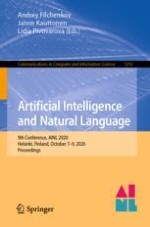2020 | Buch
Artificial Intelligence and Natural Language
9th Conference, AINL 2020, Helsinki, Finland, October 7–9, 2020, Proceedings
herausgegeben von: Andrey Filchenkov, Janne Kauttonen, Lidia Pivovarova
Verlag: Springer International Publishing
Buchreihe : Communications in Computer and Information Science
